NIAID and CC's microbiology service discover and name new bacterium
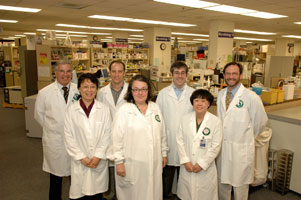 |
From left to right (back row) Drs. Patrick Murray, Adrian Zelazny, David E. Greenberg, Steven Holland, (front row) Li Ding, Frida Stock and Alexandra Wong worked together in the bacterium discovery and identification.
|
Dr. Patrick Murray, chief of the Microbiology Service in the Clinical Center's Department of Laboratory Medicine, says he remembers the day a medical technologist ran into his office and excitedly announced she had found an organism she could not identify.
Technologist Alexandra Wong recalls that day too. "I grabbed Dr. Murray and said we may have something unusual here."
They did.
With the resources and collaboration that are the hallmarks of the CC environment, NIH researchers went on to make a rare discovery. They identified a new bacterium that causes human disease, and they say it may be just the tip of the iceberg.
"Novel organisms are being found all the time, but it's quite rare to find an organism that actually causes disease in a human being,î explains Dr. David Greenberg. "It's a rare event, so this has been exciting."
Greenberg, a physician, is the lead author of a recently published study on the new bacterium. He is a clinical fellow working with Dr. Steven Holland, chief of NIAID's Laboratory of Clinical Infectious Diseases.
Greenberg has been part of this scientific journey since it began in 2003 when a man with chronic granulomatous disease (CGD) was hospitalized in the CC. CGD is a genetic immune disorder that affects about one in 250,000 people worldwide. People with CGD are susceptible to serious infections of the skin, lungs, lymph nodes and bones. They also may experience obstructive and inflammatory lesions in the digestive and urinary tracts.
The 39-year-old patient had fever, chills, fatigue and weight loss, and later developed swollen lymph nodes. When doctors at other medical centers could not make a diagnosis, he was referred to the CC. As part of his diagnostic workup, several of his lymph nodes were removed and sent to the microbiology lab. This lab does diagnostic testing for CC patients and develops tests for clinical research protocols.
Wong, with research technologist Frida Stock and Fogarty fellow Dr. Adrian Zelazny became the microbiology service team that worked tirelessly and creatively to isolate and identify the organism.
When cultures were done, an organism could be seen growing on a plate, but conventional tests could not determine what it was. Lab staffers then turned to genetic sequencing and they concluded that the bacterium was a novel member of the Acetobacteraceae family. This family of bacteria is prevalent in the environment but had not been associated with human disease before.
"That's how we knew we had something unique," says Murray, whose doctorate is in microbiology and immunology. He credits the technology in the lab and the tenacity of the scientists for making the identification. Murray says other labs may have discounted the organism as just a contaminant when conventional tests could not determine what it was. "But, we could go on because we have the resources to perform gene sequencing," he says. "If we don't get an identification by traditional biochemical tests, we send it right to sequencing. It's a very powerful tool to help us classify organisms."
"Without the microbiologists, none of this would have happened," says Holland, "We couldn't have done it without them."
Identifying the organism and verifying its novelty are just part of this discovery. Holland and his team wanted to know if this bacterium was causing disease in the patient and whether the bacterium was associated with chronic granulomatous disease. Dr. Li Ding and other researchers in Holland's lab confirmed that the organism was relevant to the patient and the disease.
Since that initial discovery in the 39-year-old patient, researchers found the bacterium in two other CGD patients at the CC and have been told of a case in another state. The scientists say learning about the case outside of Bethesda is gratifying because it indicates a broader occurrence.
Holland says the findings have both small- and large-scale possibilities. On a smaller scale, it's possible the organism accounts for a significant number of infectious episodes in CGD patients for whom doctors have never had a clear diagnosis. So the findings may prove to be very important for people with that disease.
On a larger scale, researchers want to know if the bacterium plays a role in other diseases where infectious causes have been speculated but not demonstrated—such as Crohn's disease or rheumatoid arthritis. "Finding an organism that has not been found before—and is known to be a pathogen in some individuals—suggests that we may have seen only the tip of the iceberg," says Holland. Because of the discovery, the work in Holland's lab is taking a new direction. He says his team has developed new collaborations and new techniques to learn more about the organism and the health impact it may have.
Greenberg is developing a screening test to find out how many people, with and without CGD, have been exposed to the organism. The team wants to know how prevalent the bacterium is in the environment, where exactly it comes from and why it appears to like CGD patients as a host.
While researchers have much more to learn, the collaboration between Holland's team and the microbiology service already has had an impact on CGD patients here. The CC's microbiology lab does antibiotic susceptibility testing that helps doctors determine treatments for patients. During the first patient's course of therapy, antibiotic susceptibility testing led the team to use previously untried antibiotics that proved successful. Because of what they learned in that first case, doctors were able to use that treatment from the beginning on the two other patients later identified.
"It's a nice personal feeling when you have contributed to the better health of patients," says Zelazny. "Now when patients with the same underlying disease are admitted here or to any other hospital, microbiology labs will know to look for this type of bacteria." He says he's thankful for the work environment that encourages this kind of discovery. "NIH has the people, the resources and the right setting for different people to come together. I was very fortunate to be here at the right time and to meet the right people."
Zelazny will be moving from microbiology to Holland's lab to continue work on this project and with what Greenberg calls "a fantastic partnership."
Greenberg, Zelazny, Holland and Murray named the new bacterium. After many brainstorming sessions, they chose Granulibacter bethesdensis. The first half of the name is in recognition of chronic granulomatous disease. The second half honors Bethesda, the town in which the bacterium was discovered.
As for the three CGD patients known to have the bacterial infection, all are said to be doing well. "One patient hung a picture of Granulibacter in the foyer of his house," says Greenberg, "So, there's some semblance of pride that he was one of the patients with a novel pathogen."
—By Shana Potash
Back to Top
Nurses Week adds new 'block party' to the annual festivities
 |
|
The team from OP8 received second place in the block party awards for their display, which included a homemade quilt. They are (from l to r) nurses Brent Bonfiglio, Jennifer Hunt, Laura Heytens, Margaret Lloyd, Maria Campanella and Pam Stoll. The 5SWS day hospital received first prize for their movie theater booth, and 5SES/N received third place for their guess-the-number-of-pathogens display.
|
Each year, the Clinical Center celebrates Nurses Week by honoring the hard work and significant role of its nurses. This year, the celebration became a full-blown party—with a capital "P."
Complete with block parties, an awards ceremony and a keynote address from Dr. Patricia Benner, acclaimed author and professor at the University of California, San Francisco's School of Nursing—this year's Nurses Week was off the charts according to Twanda Scales, chair of the Nursing and Patient Care Services (NPCS) retention and recognition committee and clinical manager for 1SE pediatrics.
"At the beginning we said let's make this week about teamwork," Scales noted at the awards ceremony. "And you guys blew me away."
National Nurses Week, which was May 8-12, offered nurses and the CC community a chance to get to know one another better through block parties„a new addition to the Nurses Week lineup. Each patient care unit was asked to create a booth or table with the American Nurses Association theme "Strength, Commitment and Compassion." When the groups set up shop in their floors' atrium areas, the showcase was so overwhelming that the committee created a new award category for best block-party teamwork.
Nurses from OP4, 7 and 10 passed out blended fruit drinks as part of their luau-themed booth while 5SES/N's visitors were invited to guess the number of candies in a jar (or in this case, pathogens and red blood cells).
The 5SWS day hospital created an entire movie theater experience as its display„complete with movie posters, a popcorn maker, candy counter treats and a banner that read, "Now Playing: A Picture of Success."
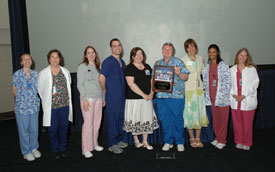 |
The adult oncology patient care unit's 3NW nurses were awarded the Nursing Team Excellence Award. They are (from l to r) Clara Borrell, Barbara Rawlings, Jennifer Breeskin, Keith Marin, Leigh Kiger, Tye Mullikin, Clare Hastings, Debbie Nathan and Lori McIntyre. The 3NE nursing team for oncology/hematology was recognized as the runner-up.
|
Delicious food was also available at OP8's booth, along with an intricate quilt hanging as a backdrop. With the message, "OP8 Piecing It All Together," each patch represented a different staff member's contribution. Every piece of fabric was a personal item, whether it was someone's old pajamas, a child's piece of clothing or upholstery scraps from their home. "We worked together a few Saturdays and Sundays to get it done," said Margaret Lloyd.
On May 11, the NPCS executive group—including Dr. Clare Hastings, chief of nursing and patient care services, and the retention and recognition committee—made rounds to the patient care areas and outpatient clinics on all three shifts to express their appreciation for the staff�?s hard work.
After four days of celebration, the week concluded with an awards ceremony and reception. Based on nominations submitted by their colleagues, the nurses of 3NW received the Team Excellence Award. "You are one of the most active groups to affect nursing practice here," said Hastings. "You ensure that flawless patient experience every day."
—By Kathryn Boswell
Back to Top
NIH-Duke program graduates honored at Clinical Center reception
Since its start in 1998, the NIH-Duke Training Program in Clinical Research—a collaboration between the NIH Clinical Center and Duke University Medical Center—has seen the number of its graduates rise with each passing year. On May 11, Dr. Frederick Ognibene, director of the CC's Office of Clinical Research Training and Medical Education, congratulated the following nine graduates of the 2005-06 academic term: Drs. Daniel Aletaha (May 2006), Alicia Armstrong (May 2006), Michael Boyiadzis (August 2005), Michael Cox (December 2005), Elizabeth Fox (May 2006), Raphaela Goldbach-Mansky (August 2005), Linda Mah (May 2006), Thomas Nugent, III (May 2006) and Rebecca Thomas (May 2006).
While the formal graduation ceremony is held at the Duke University campus in Durham, N.C., each year Duke sponsors a reception at the CC honoring its NIH graduates. Four of this year's graduating students joined Ognibene for this year's event, along with Dr. John I. Gallin, CC director, and Dr. Linda Lee, associate director of the Duke program.
"We are delighted that our partnership with Duke has been so successful," Gallin said as he
 |
(l to r) Drs. Elizabeth Fox, Alicia Armstrong and Raphaela Goldbach-Mansky, graduates, CC director Dr. John I. Gallin, Dr. Daniel Aletaha, graduate, and Dr. Frederick P. Ognibene, director, Clinical Research Training and Medical Education, gathered for the May 11 reception honoring the NIH-Duke Program in Clinical Research�?s graduating students.
|
addressed the reception attendees. "I hope you will apply this knowledge well and share it with the next group."
The program offers students a chance to earn a master of health sciences in clinical research degree while they continue to take advantage of hands-on research opportunities at NIH. It is designed primarily for clinical fellows and other health professionals training for careers in clinical research. Courses include research design, statistical analysis, health economics, research ethics, and research management. NIH participants complete course work primarily through videoconferences with Duke faculty. NIH staff teach courses on site as Duke adjunct faculty.
"The program has given me a very good systematic view of things," said Aletaha, a clinical researcher at the Medical University of Vienna�?s department of rheumatology who has been working as a research fellow at NIAMS. "I was doing decent research before, but when I wanted to learn more about a subject, I could only read books—here I have been able to get the experience."
Individuals interested in applying for the next academic term are encouraged to visit http://www.cc.nih.gov/training/duke.html. Applications will be available November 1, 2006 and the submission deadline is March 1, 2007.
Back to Top
Friends and colleagues say farewell to Susan Harris
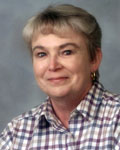 |
Susan Harris was remembered a friend
and hard-working professional.
|
Friends and colleagues remembered Susan Beverly Harris, a DCRI staff member and most recently an IT specialist in the Information Technology Center, as the consummate professional who loved mountains, basketball and old-fashioned southern hospitality. Harris, 63, died on April 27. Her memorial service was held in the Hatfield Center chapel on May 4.
"Susan was spicy," said Kathleen P. Krisko, administrative officer with the Office of Administrative Management and Planning. "She had a twinkle in her eye and a temper, but she was passionate about her family, friends and her work. There isn't one quality that stands out for me in regard to Susan—it was a combination of her talents that made her such a unique person."
Dr. Stephen J. Rosenfeld, former CC chief information officer, wrote in his tribute to Harris: "As a doctor at NIH, I saw many people with incurable cancer, many people with different ways of facing death. Susan's approach was something I had never seen. She did not, as so many people do, look to her past for some reason, something she had done, which led to her cancer. She didn't dwell on her pain or her present circumstance. She just had no time or patience for her cancer—she wanted to move on with her life."
Harris began her career as a recreational therapist in Richmond, Va., where she worked to give many underprivileged children a safe playground and structured activities. She soon developed a love for basketball and began to polish her playing skills. She subsequently moved to the Washington, D.C., area to pursue a career as a medical technologist for Hazelton Laboratories, quickly developing a life-long passion for research.
She began her NIH career in August 1993 and fulfilled her dream of completing college, earning a B.A. in Human Relations from Trinity College. Harris' many CC positions included senior program support specialist, manager for the hospital's clinical research information system (CRIS) practice lab and, finally, as an IT specialist.
"We were a family," said colleague and friend Dr. Jon McKeeby, CC acting chief information officer. "Susan was our favorite aunt who gave soul to the department and the CRIS project," he said. "Whatever Susan did for the CRIS Steering Committee—managing the practice lab, taking minutes at meeting after meeting or everything, or even cooking food for the team—whenever I asked what she was doing, she replied, "Building CRIS!"
"Everyone knows the expression 'live every day as if it could be your last,'" said Rosenfeld. "Susan lived every day as if it were her first. She was always looking to start something new, whether it was going back to school, taking over the CRIS practice lab, or working in the IT center."
"Susan loved animals, art, music, golf, the Redskins, antiques, cooking and gardening," said Krisko. "She adopted a dog, Nicole, who brought much joy to her life over the last two years. But most importantly she loved people."
Susan is survived by two sisters, Paulina Anderson Harris of St. Simons Island, Ga., and Evelyn Christine Maschue of Divide, Colo.; a brother, George Harris; a host of aunts, uncles, nieces, nephews, cousins and, of course, her NIH family.
—By John Iler
Back to Top
Cancer fatigue awareness day invites patients and families to learn more about treating symptoms
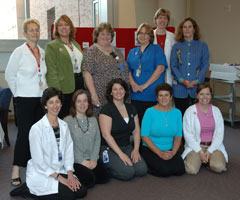 |
Front row (l to r) Ellen Levy, Myra Woolery, Anne Jacobs, Donna Pereira, Paula Schum and back row (l to r) Caryn Steakley, Paula Muehlbauer, Georgie Cusack, Jamie Kirkpatrick, Paula Rothenberg and Kathy Farrell are some of the NIH employees who shared their time and expertise as part of the day's events.
|
Cited as the most common side effect of cancer and its treatment, cancer fatigue affects 76 percent of cancer patients undergoing therapy. Described as a total lack of energy and feeling tired, weak or "wiped out," cancer fatigue is often underreported, under-recognized and under-treated. In recognition of the impact that fatigue can have on a cancer patient's life, NCI's Center for Cancer Research and the CC Nursing Department cosponsored this year's Cancer Fatigue Awareness Day, which was held on April 25 in the Clinical Center.
Designed to inform patients about the ways to measure and fight fatigue, Cancer Fatigue Awareness Day treated approximately 100 patients and their families to healthy snacks, relaxation sessions and one-on-one time with health experts from the Rehabilitation Medicine Department's recreational therapy and occupational therapy sections, Nutrition Department, Nursing and Patient Care Services, the Pain and Palliative Care Consult Service and the nonprofit organization, the Wellness Community. Visitors also had a chance to hear presentations on the topics of Reiki therapy (when a therapist lightly touches various points on a patient's body), phytochemicals (bioactive compounds in plants that work with other nutrients to promote good health), exercise programs and guided imagery.
—By Georgie Cusack,
Clinical Nurse Specialist, Ambulatory Hematology/Oncology
Back to Top
Great Teachers series sparks lively discussion as program originator honored at last lecture under his stewardship
As chair of the Great Teachers lecture series, Dr. Paul Plotz not only planted the first seeds of the
|
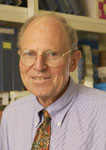
|
After creating the Great Teachers lecture series, Dr. Paul Plotz chaired the program for five years.
|
program, he cultivated and grew it into the success it is today. In recognition of Plotz's five years at the helm, Dr. John I. Gallin, CC director, presented him with a coveted "Dirt Award" at the Great Teachers lecture on May 10—the last that Plotz would coordinate as series chair.
"This is Paul's last session as chair, and I would like to present him with what I call a 'dirt award,'" Gallin explained. The award encapsulates a handful of soil turned during the groundbreaking for the Hatfield Clinical Research Center and collected by Gallin hours after the 1997 ceremony. He had the award created to honor individuals who have made remarkable contributions to the Clinical Center and its programs. Plotz's award was inscribed: "For building and sustaining the Contemporary Clinical Medicine Teachers Series of Clinical Center Grand Rounds 2001-2006."
Since its inception, the widely successful Great Teachers series has fueled enthusiasm among clinical physicians and delivered practical medical advice. Composed of ten lectures annually, the series is part of the weekly Clinical Center Grand Rounds.
Plotz originally conceived the idea for the series when he was chair of the NIH/FAES continuing medical education committee. Charged with enhancing education programs on campus, Plotz and the committee surveyed NIH physicians to find out what clinical topics would be of interest to them. With the survey results in hand, the committee invited physicians from the United States and abroad who were best suited to address a particular topic, based on their reputations as outstanding clinicians and great teachers.
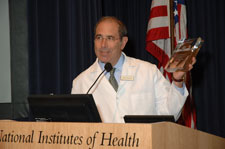 |
Gallin holds up the "Dirt Award," which encapsulates a handful of soil from the Hatfield groundbreaking.
|
"I congratulate Paul on this award," said Dr. Michael Gottesman, NIH deputy director for intramural research, who introduced the May 10 speaker—Dr. Faith Fitzgerald. "The conception and execution of this series has been entirely his."
It was fitting that Fitzgerald—who was the final speaker for the inaugural 2001-2002 Great Teachers series—presented at Plotz's last session as chair. As assistant dean of Humanities and Bioethics at the University of California, Davis, Fitzgerald is the only Great Teachers speaker to be invited back a second time.
She engaged the audience, which overflowed into seats outside the auditorium, with a lively discussion on "Mysterious Cases." Plotz presented Fitzgerald with several difficult, real-life medical cases and she reasoned her way to a possible explanation of the described maladies. At one point, obviously stumped by the problem, she invited the audience to assist her. "Come on folks. Medicine is a college. What do you think?" After tossing ideas back and forth with participating audience members, Fitzgerald congratulated one young woman when her hypothesis proved to be right.
Beginning next season, Dr. Jeffrey Cohen, head of the Medical Virology Section in the Laboratory of Clinical Infectious Diseases, NIAID, will assume stewardship of the program as the new chair of the Great Teachers series.
—By Kathryn Boswell
Back to Top
Life-saving devices installed throughout the Hatfield building
When cardiac arrest occurs, research from the American Heart Association shows that one has a better chance of survival if an electric shock—called a defibrillation—is delivered to the heart within minutes of the attack. To date, none of the 33 automated external defibrillators (AEDs) that were installed in the Magnuson building in 2002 have been needed for an emergency, and hospital administrators hope the same will be true of the more than 60 new AEDs in the Hatfield building. Combined, there are now almost 100 total AEDs located throughout Building 10.
 |
Approximately 60 AED stations have been placed throughout the Hatfield Center, bringing the total number of AEDs in the Clinical Center to about 100. NIH CPR training is required to use the devices.
|
Housed in plastic cabinets on every floor of the Hatfield Center, the AEDs are located at most elevator banks. Each cabinet houses a small, four-pound defibrillator that automatically detects the heart rhythm of a sudden cardiac arrest victim and determines whether the victim needs a shock to help restore normal heart rhythm.
"We placed them in standard locations so that, in case of emergency, people would not have to think about where they are located," says Debra Byram, senior administrative officer in the CC Office of Administrative Management. Symbols will also be added to all CC maps designating the locations of the defibrillators in the building.
Opening the AED cabinet activates a loud continuous alarm and allows the AED unit to be removed. Instructions are posted by each cabinet, and the unit gives easy-to-understand screen messages and voice prompts on what steps to take. Employees should also follow regular Building 10 Code Blue procedures by dialing 111 for any medical emergency.
In case of a false alarm, in which an alarm is sounded but there is no one in distress, page the respiratory therapy section and provide the exact AED location.
Back to Top
Visiting eighth-graders get inside look at NIH research
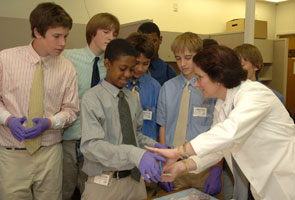 |
Dr. Maria Merino, NCI, invites Landon School students to learn about the pathology of tumors through hands-on work with lab samples.
|
A group of about 80 young men dressed in blazers and ties descended on the Clinical Center on April 27. No, they weren't members of a secret government agency—they were students from the Landon School in Bethesda.
The eighth graders were invited to the CC to get some hands-on experience as part of their assigned science projects. They listened to lectures on infectious diseases from Drs. Peter Eichacker, head of the Critical Care Medicine Department's critical care section, Henry Masur, chief of the Critical Care Medicine Department, and Department of Laboratory Medicine postdoctoral fellow Susan Harrington; observed real-life tumor samples with Dr. Maria Merino, NCI chief of surgical pathology; visited the lab of Dr. Peng Loh, chief of NICHD's cellular neurobiology section; and watched as one of their classmates was sent through the PET scanner under the supervision of Dr. Ron Neuman, chief of the Nuclear Medicine Department.
Back to Top
A special thanks to the planners and organizers of Nurses Week
May 8-12 marked the national Nurses Week celebration, themed "Strength, Commitment, Compassion."
One out of every three employees at the CC is a nurse, according to Dr. Clare Hastings, chief of Nursing and Patient Care Services. Since 1974, when President Richard Nixon declared a National Nurses Week, hospitals and health-care providers have been celebrating the contributions of its nurses nationwide. Today there are more than 2.9 million nurses across the country.
Pictured below are members of the Retention and Recognition Nurses Week Subcommittee as they celebrate the news that they get two days off for all their hard work in planning and organizing this year's successful Nurses Week activities.
 |
|
Members of the Retention and Recognition Nurses Week Subcommittee from left to right are: Anne Marie Matlock, Julie Kohn, Brent Bonfiglio, Madeleine Cooper, Jeff Aberle, Cynthia Herringa, Teresa Kessinger, Kim Pinckney, Louise Canada, Gloria Babilonia-Auykawa, Twanda Scales (chair), Rosa Clark (chair of the Nurses Week Celebration Committee), Allison Adams-McLean (chair elect) and Dr. Clare Hastings, chief of Nursing and Patient Care Services.
|
Back to Top
Upcoming Events
May 10 (Wednesday)
Noon–1 p.m. Lipsett Amphitheater
Contemporary Clinical Medicine: Great Teachers Grand Rounds: Mysterious Cases
Faith Fitzgerald, MD, Assistant Dean of the Humanities and Bioethics, University of California, Davis
June 12-13 Tuesday & Wednesday
9 a.m. Masur Auditorium
General Motors Cancer Research Awards Annual Scientific Conference—Genomics and Cancer World's foremost researchers. Contact (919) 684-4056 or mary.ruemker@duke.edu for more information or visit http://odwww4.od.nih.gov/gmcr/.
June 14 (Wednesday)
Noon–1 p.m. Lipsett Amphitheater
Grand Rounds: Physical Activity and Breast Cancer
Jennifer Eng-Wong, M.D., M.P.H., Staff Clinician, Medical Oncology Branch, CCR, NCI
C and Its Tight Control in Humans: Consequences for Health, Disease and Disease Treatment
Mark Levine, M.D., Chief, Molecular and Clinical Nutrition Section, NIDDK
June 16 (Friday)
8 a.m.–3:30 p.m. Masur Auditorium
Celebrating Nursing Science: The Research-Practice Link
This conference, hosted by NINR and CC Nursing and Patient Care Services, is designed to celebrate the achievements in clinical nursing research and their application to practice. Clinicians and researchers who are interested in exploring the research practice link can register to attend at http://www.cc.nih.gov/nursing.
June 21 (Wednesday)
Noon–1 p.m. Lipsett Amphitheater
HIV-Related Opportunistic Infections in the Era of HAART
Joseph A. Kovacs, M.D., Senior Investigator, Head, AIDS Section, Critical Care Medicine Department, CC
The Dark Side of HAART: Metabolic Complications of HIV Therapy
Caryn G. Morse, M.D., M.P.H., Staff Clinician, Critical Care Medicine Department, CC
June 21 (Wednesday)
3 p.m. Masur Auditorium
NIH Director's Lecture
Diana Bianchi, M.D., Natalie V. Zucker Professor of Pediatrics, Obstretics and Gynecology, Tufts NE Medical Center
June 28 (Wednesday)
Noon–1 p.m. Lipsett Amphitheater
Re-Establishing Volitional Swallowing in Chronic Pharyngeal Dysphagia
Christy L. Ludlow, Ph.D., Chief, Laryngeal and Speech Section, Medical Neurology Branch, NINDS
Anti-Angiogenic Agents and Prostate Cancer
William L. Dahut, M.D., Chief, Genitourinary Clinical Research Section, Medical Oncology Branch, CCR, NCI
July 4 (Tuesday)
Independence Day
Federal holiday
To view other NIH and Clinical Center events, click here.
Back to Top
|
|
Clinical Center News, National
Institutes of Health, Building 10, 10 Center Drive, Room 12C440, Bethesda, MD 20892-1504. Tel: 301-496-6787.
Fax: 301-402-2984. Published monthly for CC employees
by the Office of Communications, Patient Recruitment, and Public Liaison. News, article ideas,
calendar events, letters, and photographs are welcome.
Back to Top
|
|


 The information on this page is archived and provided for reference purposes only.
The information on this page is archived and provided for reference purposes only.